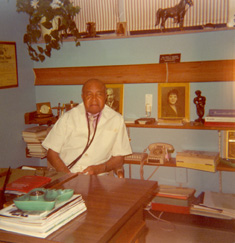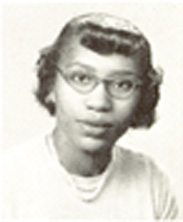By Suzanne Maggard
In the Archives and Rare Books Library, we help students, faculty, and even outside researchers with their projects, so it is always exciting when we are able to reap the benefits of great student projects of the past. One such project is a collection of oral histories organized by Eleanor Smith, a professor in the Afro-American Studies Department (now the Department of Africana Studies) at UC. Smith was inspired to direct this project after encountering a lack of information on black Cincinnatians in the area’s libraries and archives. She designed an oral history class to change that and in 1975 and 1976, Smith’s students conducted interviews with 23 African-Americans in Cincinnati from a variety of backgrounds. The oral histories that resulted from this project provide a unique view of African American life in Cincinnati in the early and mid-20th century and shed light on the experiences of African Americans in a city where segregation may not have always been in writing, but was certainly the norm. Those who were interviewed saw the importance of passing on their stories to the next generation. Although equal rights were still being sought in the mid-1970s and are still a struggle today, leaps and bounds were made in the lifetimes of many of these men and women and their stories taught the student interviewers important lessons.
Those leaps and bounds are apparent in the life of Dr. Rufus Atwood, the son of a slave who became president of Kentucky State College. Atwood served in World War I in the Signal Corps of the 92nd division, the only African American division in the U.S. Army at the time. He explains in an interview in this collection that many of the black soldiers believed that the war was a chance to show their loyalty as Americans and they could “earn the rights of any first-class American.” Yet even before the soldiers left Europe, Dr. R.R. Moton, President of the Tuskeegee Institute, told the black troops “not to expect too much” when they came home. The reality of the situation hit Atwood and some friends soon after they returned home and were refused a cab ride. Atwood was not deterred from his quest for first class citizenship for himself and other African Americans. He completed his degree at Iowa State College and became President of Kentucky State College. At Kentucky State, he succeeded in gaining accreditation for the historically black college at the same level as Kentucky’s other public colleges and universities.
Atwood is not the only interviewee who succeeded through sheer determination. Dr. Ray E. Clarke, could treat patients in his own practice, but was unable to gain privileges at any of Cincinnati’s local hospitals during the 1920s, but through the help of friends in the medical field who verified his skills as a doctor he slowly gained these rights. In 1937 General Hospital finally allowed black doctors to serve as clinicians, and Clarke was allowed to perform surgery in a Cincinnati hospital. When he was admitted to the staff of General Hospital, he was also appointed to a faculty position in UC’s College of Medicine. Ironically, Clarke was unable to practice at Christ Hospital, Jewish Hospital, or Bethesda Hospital, but he oversaw medical students as an instructor in the surgery department in the College of Medicine and taught students who would be able to practice at those other hospitals upon graduation.
A few years later, Eddie Sellers sought equality for black nurses in Cincinnati. Sellers never intended to become a nurse, but, as a good student, she was asked by the NAACP and the Urban League to take UC’s College of Nursing’s admittance test to prove that a black student could pass it. Sellers and a fellow high school student passed and were admitted to the College of Nursing, but still experienced discrimination. During orientation in 1947, they were approached by a faculty member who informed them bluntly that they were not wanted. Sellers persevered and graduated in 1951, among the top three in her class.
There are countless engrossing stories in these interviews, which provided the student interviewers with lessons that are not so easily learned in the classroom. As Vanessa J. Pearson, a junior, writes in her evaluation of the project, “I learned about the problems of Blacks and their inner strength to endure stress, the pride they took in their work, and their ability to still be able to laugh, to smile, and have a kind word. It is no wonder that they have become highly respected in their communities and fields. For me this project gave reason to hope.” This great student project, not only taught Smith’s students lessons in 1975 and 1976, but also can pass on new lessons to today’s students, faculty, and researchers. The collection of interviews in the Archives and Rare Books Library includes the original cassette recordings, transcripts of the interviews, and some photographs of the interviewees. For a complete list of the interviews, see the finding aid for this collection on OhioLINK at http://rave.ohiolink.edu/archives/ead/OhCiUAR0260 or come in to the Archives and Rare Books Library to take a look. We’re located on the 8th floor of Blegen Library, and you can reach us for questions at 513-556-1959 or by email at archives@ucmail.uc.edu.



